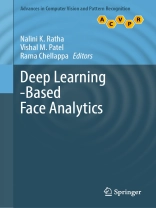This book provides an overview of different deep learning-based methods for face recognition and related problems. Specifically, the authors present methods based on autoencoders, restricted Boltzmann machines, and deep convolutional neural networks for face detection, localization, tracking, recognition, etc. The authors also discuss merits and drawbacks of available approaches and identifies promising avenues of research in this rapidly evolving field.
Even though there have been a number of different approaches proposed in the literature for face recognition based on deep learning methods, there is not a single book available in the literature that gives a complete overview of these methods. The proposed book captures the state of the art in face recognition using various deep learning methods, and it covers a variety of different topics related to face recognition.
This book is aimed at graduate students studying electrical engineering and/or computer science. Biometrics is a course that is widely offered at both undergraduate and graduate levels at many institutions around the world: This book can be used as a textbook for teaching topics related to face recognition. In addition, the work is beneficial to practitioners in industry who are working on biometrics-related problems. The prerequisites for optimal use are the basic knowledge of pattern recognition, machine learning, probability theory, and linear algebra.
Tabella dei contenuti
1. Deep CNN Face Recognition: Looking at the Past and the Future.- 2. Face Segmentation, Face Swapping, and Their Effect on Face Recognition.- 3. Disentangled Representation Learning and its Application to Face Analytics.- 4. Learning 3D Face Morphable Model from In-the-wild Images.- 5. Deblurring Face Images using Deep Networks.- 6. Blind-Superresolution of Faces for Surveillance.- 7. Hashing a Face.
Circa l’autore
Nalini K. Ratha is Empire Innovation professor in the Department of Computer Science and Engineering at University at Buffalo (New York). Before joining UB, he was Research Staff Member at IBM T. J. Watson Research Center, Yorktown Heights, NY. He received his Ph.D. in Computer Science from Michigan State University, East Lansing, MI, B. Tech. in Electrical Engineering, and M. Tech. in Computer Science and Engineering from Indian Institute of Technology, Kanpur. Nalini is Fellow of IEEE and IAPR. He received the Biometrics Council Leadership Award in 2019 and served as the President of the IEEE Biometrics Council in 2011–2012. At IBM Research, he was designated as IBM Research Master Inventor in 2018 and received two IBM Research Division awards, an IBM Outstanding Technical Achievement Award, and an IBM Outstanding Innovation Award. He has served as Associate Editor for IEEE Trans. on PAMI, IEEE Trans. on SMC-B, IEEE Trans. on Image Processing and Journal of Pattern Recognition. He is co-author and co-editor, respectively, of the Springer books, Guide to Biometrics and Advances in Biometrics, and co-edited several other books. He has served as General and Program Co-Chair for many biometrics and AI-related conferences and workshops.
Vishal M. Patel is Assistant Professor in the Department of Electrical and Computer Engineering at Johns Hopkins University (JHU). Prior to joining Hopkins, he was A. Walter Tyson Assistant Professor in the Department of ECE at Rutgers University and Member of the research faculty at the University of Maryland Institute for Advanced Computer Studies (UMIACS). He completed his Ph.D. in Electrical Engineering from the University of Maryland, College Park, MD, in 2010. He has received a number of awards including the 2016 ONR Young Investigator Award, the 2016 Jimmy Lin Award for Invention, A. Walter Tyson Assistant Professorship Award, Best Paper Award at IEEE AVSS 2017, Best Paper Award at IEEE BTAS 2015, Honorable Mention Paper Award at IAPR ICB 2018, two Best Student Paper Awards at IAPR ICPR 2018, and Best Poster Awards at BTAS 2015 and 2016. He is Associate Editor of the IEEE Signal Processing Magazine, and IEEE Biometrics Compendium, and serves on the Information Forensics and Security Technical Committee of the IEEE Signal Processing Society. He is Member of Eta Kappa Nu, Pi Mu Epsilon, and Phi Beta Kappa.
Rama Chellappa is Bloomberg Distinguished Professor in the Departments of Electrical and Computer Engineering and Biomedical Engineering at JHU. He is co-author and co-editor, respectively, of the Springer books, Unconstrained Face Recognition and Handbook of Remote Biometrics. At JHU, he is also affiliated with MINDS, CIS, and CLSP and the Malone Center for Engineering in Healthcare. He holds a non-tenure position as College Park Professor in the ECE department at University of Maryland (UMD). Before coming to JHU in August 2020, he was Distinguished University Professor, Minta Martin Professor of Engineering, Professor in the ECE department at the University of Maryland Institute Advanced Computer Studies. At UMD, he was also affiliated with the Center for Automation Research and the Department of Computer Science. From 1981-1991, he was Assistant and Associate Professor in the Department of EE-Systems at the University of Southern California. He received B.E. (Hons.) degree in Electronics and Communication Engineering from the University of Madras, India, in 1975 and M.E. (with distinction) degree from the Indian Institute of Science, Bangalore, India, in 1977. He received M.S.E.E. and Ph.D. degrees in Electrical Engineering from Purdue University, West Lafayette, IN, in 1978 and 1981, respectively. His current research interests are computer vision, machine learning, artificial intelligence, signal and image/video processing. Chellappa received an NSF Presidential Young Investigator Award, four IBM Faculty Development Awards, an Excellence in Teaching Award from the School of Engineering at USC, and several paper awards from Biometrics and Pattern Recognition conferences. He is a recipient of the 2020 IEEE Jack S. Kilby Signal Processing Medal. He is also a recipient of the K.S. Fu Prize from the International Association of Pattern Recognition (IAPR). He received the Society, Technical Achievement, and Meritorious Service Awards from the IEEE Signal Processing Society. He also received the Technical Achievement and Meritorious Service Awards from the IEEE Computer Society. Recently, he was recognized with the inaugural Leadership Award from the IEEE Biometrics Council. At UMD, he was elected as Distinguished Faculty Research Fellow, and as Distinguished Scholar-Teacher, and received three Outstanding Innovator Awards from the Office of Technology Commercialization, and an Outstanding GEMSTONE Mentor Award from the Honors College. He received the Outstanding Faculty Research Award and the Poole and Kent Teaching Award for Senior Faculty from the College of Engineering. In 2010, he was recognized as an Outstanding ECE by Purdue University. He also received the Distinguished Alumni Award from the Indian Institute of Science in 2016. He is Fellow of IEEE, IAPR, OSA, AAAS, ACM, and AAAI. He holds eight patents. Chellappa served as Editor-in-Chief of IEEE Transactions on Pattern Analysis and Machine Intelligence. He has served as General and Technical Program Chair for several IEEE international and national conferences and workshops. He is Golden Core Member of the IEEE Computer Society and served as Distinguished Lecturer of the IEEE Signal Processing Society. He served as the inaugural President of the IEEE Biometrics Council.












